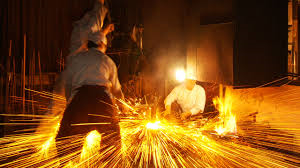Votre panier est vide


Pioneering iconic swords like the katana and uchigatana, Japan is widely recognized as being one of the world's leading producers of fine blades. However, there's a long and rich history behind Japanese bladesmithing, which we're going to explore in this post.
Origins of Japanese Bladesmithing
Some people assume that Japanese pioneered the art of bladesmithing on its own, but this isn't necessarily true. Historians believe Japan first obtained the technology to produce swords, knives and other blades from China. Ancient Chinese bladesmithing techniques were transferred to Japan through the Korean Peninsula.
According to "The Craft of the Japanese Sword," the oldest known Japanese swords date back to about the fourth of fifth century AD. These swords weren't used for fighting or other militaristic purposes, however. Instead, they were used strictly for ceremonial purposes.
In the Hein period to follow, Japan began to produce curved fighting swords like the tachi, which proved more beneficial than straight-bladed swords when used by samurai warriors on horseback.
How the Mongol Invasions Affected Japanese Bladesmithing
Beginning in 1274 and lasting until 1281, the Mongols, under the leadership of Kublai Khan, embarked on a military effort to conquer Japan. While Japan ultimately proved victorious in fending off the invading Mongol forces, this served as a tipping for its bladesmithing practices.
Prior to this period, Japanese swordmaking involved the use of locally source metal, which was lower quality than metals in found other regions. Swordsmiths would fold and forge blades multiple times to create a somewhat stronger -- though still relatively weak -- sword. With the Mongols constantly attacking, however, Japanese swordsmiths began to experiment with new techniques in an effort to produce a stronger and more viable sword.
This led to the advent of carbon-steel swords, during which would later become known as Japan's "Golden era" of bladesmithing. Japanese swordsmiths would essentially wrap low-carbon steel in a blanket of high-carbon steel, after which they would harden the edge. This technique was later perfected to be even more effective through the use of differential hardening, which we explain in a previous post.
The Muromachi Period
The Muromachi period was also an important time for Japanese bladesmithing, as it gave way to the katana and tanto. While still defending against the threat of Mongols, Japanese swordsmiths focused their attention on producing multi-purpose swords that could be used on horseback and in hand-to-hand combat. The katana was one such versatile sword that proved effective this regard.
Today, Japan remains one of the world's most recognizable producers of high-quality swords and knives.